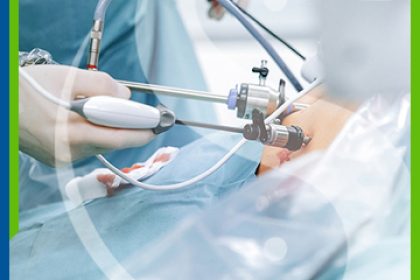
All hernias can be treated via laparoscopic surgery.
Inguinal (groin) hernia: 75% of all hernia occur in groin area. 90% of inguinal (groin) hernia is seen in men. There are three types of inguinal hernia, namely direct, indirect and femoral. Direct hernia is protrusion of hernia due to weakened abdominal wall layers. Indirect hernia is advancement of the abdominal contents such as fat and bowels into scrotum via inguinal canal. Femoral hernia occurs right under the groin and seen more common in women. This type carries high risk for strangling.
Umbilical hernia: The duct in belly button is naturally closed after birth. However, this opening may not completely close, and cause hernia since it is a weak spot on the abdominal wall.
Incisional hernia: This type of hernia develops at surgical sites after abdominal surgeries. It occurs after abdominal surgeries at a rate of 3-10%. Incisional hernias are seen much less frequently after laparoscopic surgery.
Epigastric hernia: This type of hernia occurs in the area over the belly button.
Spiegel hernia: This type of hernia occurs between the muscle layers located at both sides of lower abdominal area.
Diagnosis of hernia
The most crucial step in the diagnosis of hernia is physical examination. Ultrasonography provides excellent view on hernias, however, imaging methods such as computerized tomography or MRI can also be used to assist diagnosis of hernia when examination findings are obscure.
What are the treatment procedures for hernia?
The only effective treatment procedure is surgical repair. Several surgical procedures have been tried in years, and there are now methods considered as standard. Today, hernia surgeries are performed in two methods. The first one is the classical (open) method performed through an incision around area where the hernia is present. The second method is the laparoscopic (closed) hernia repair method developed in line with the latest technological advances.
How is laparoscopic hernia surgery performed?
Laparoscopic (closed) hernia repair is performed under general anesthesia through small incisions in upper or lower abdominal area, using laparoscopy technology and a suitable patch. This procedure enables surgeon to see the hernia and surrounding tissues through a hollow channel using a telescope fitted with a camera. Hernia is then closed with a special surgical patch, and fixed using small surgical staples or surgical glue. The entire procedure is performed in a closed system.
After the laparoscopic hernia surgery, less pain is experienced compared to open surgery, and recovery is faster. Patients can get back to work and daily activities faster (patients are able to perform daily activities in 2-3 days, and can get back to active work in 5-7 days, and can drive vehicle in 10 days). Laparoscopic surgery is particularly advantageous in recurrent hernia. Less surgical infection, less numbness, and smaller surgical scar make the procedure more preferable. It is also very advantageous in athletes because postoperative performance loss is neglectable in laparoscopic repair.

